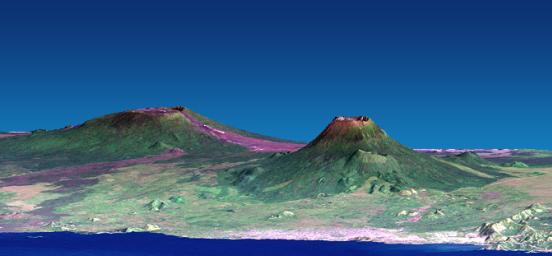The Nyiragongo volcano in the Congo erupted on January 17, 2002, and subsequently sent streams of lava into the city of Goma on the north shore of Lake Kivu. More than 100 people were killed, more than 12000 homes were destroyed, and hundreds of thousands were forced to flee the broader community of nearly half a million people. This computer generated visualization combines a Landsat satellite image and an elevation model from the Shuttle Radar Topography Mission (SRTM) to provide a view of both the volcano and the city of Goma, looking slightly east of north.
Nyiragongo is the steep volcano on the right, Lake Kivu is in the foreground, and the city of Goma has a light pink speckled appearance along the shoreline. Nyiragongo peaks at about 3470 meters (11,380 feet) elevation and reaches almost exactly 2000 meters (6560 feet) above Lake Kivu. The shorter but broader Nyamuragira volcano appears in the left background. Topographic expression has been exaggerated vertically by a factor of 1.5 for this visualization.
Goma, Lake Kivu, Nyiragongo, Nyamuragira and other nearby volcanoes sit within the East African Rift Valley, a zone where tectonic processes are cracking, stretching, and lowering the Earth's crust. Volcanic activity is common here, and older but geologically recent lava flows (magenta in this depiction) are particularly apparent on the flanks of the Nyamuragira volcano.
The Landsat image used here was acquired on December 11, 2001, about a month before the eruption, and shows an unusually cloud-free view of this tropical terrain. Minor clouds and their shadows were digitally removed to clarify the view, topographic shading derived from the SRTM elevation model was added to the Landsat image, and a false sky was added.
Landsat has been providing visible and infrared views of the Earth since 1972. SRTM elevation data matches the 30-meter (98-foot) resolution of most Landsat images and substantially helps in analyzing the large and growing Landsat image archive. This Landsat 7 Thematic Mapper image was provided to the SRTM project by the United States Geological Survey, Earth Resources Observation Systems (EROS) Data Center, Sioux Falls, S.D.
Elevation data used in this image was acquired by the Shuttle Radar Topography Mission (SRTM) aboard the Space Shuttle Endeavour, launched on Feb. 11, 2000. SRTM used the same radar instrument that comprised the Spaceborne Imaging Radar-C/X-Band Synthetic Aperture Radar (SIR-C/X-SAR) that flew twice on the Space Shuttle Endeavour in 1994. SRTM was designed to collect 3-D measurements of the Earth's surface. To collect the 3-D data, engineers added a 60-meter (approximately 200-foot) mast, installed additional C-band and X-band antennas, and improved tracking and navigation devices. The mission is a cooperative project between NASA, the National Imagery and Mapping Agency (NIMA) of the U.S. Department of Defense and the German and Italian space agencies. It is managed by NASA's Jet Propulsion Laboratory, Pasadena, Calif., for NASA's Earth Science Enterprise, Washington, D.C.
Size: View width 21 kilometers (13 miles), View distance 42 kilometers (26 miles)
Location: 1.5 deg. South lat., 29.3 deg. East lon.
Orientation: View east-northeast, 5 degrees below horizontal
Image Data: Landsat Bands 3, 2, 1 as red, green, blue, respectively. Original Data Resolution: SRTM 1 arcsecond (30 meters or 98 feet), Landsat 30 meters (98 feet)
Date Acquired: February 2000 (SRTM), 11 December 2001 (Landsat)

 Planetary Data System
Planetary Data System












